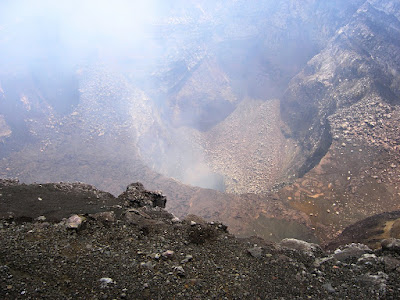when you see them hover around high above the sky with the giant wings you might fall in love with them.
They are gregarious so they usually hover or flock together but now I see the very lonely one keep standing and watching down the hole of the fuming crater.
I like to call him Watch Vulture of Volcan Masaya..











 It soars high while searching for food, holding its wings horizontally when gliding. It flaps in short bursts which are followed by short periods of gliding. Its flight is less efficient than that of other vultures, as the wings are not as long, forming a smaller sail surface. In comparison with the Turkey Vulture, the American Black Vulture flaps its wings more frequently during flight. It is known to regurgitate when approached or disturbed, which assists in predator deterrence and taking flight by decreasing its takeoff weight. Like all New World Vultures, the American Black Vulture often defecates on its own legs, using the evaporation of the water in the feces and/or urine to cool itself, a process known as urohydrosis. It cools the blood vessels in the unfeathered tarsi and feet, and causes white uric acid to streak the legs. Because it lacks a syrinx, the American Black Vulture, like other New World Vultures, has very few vocalization capabilities. It is generally silent, but can make soft hisses and grunts.
It soars high while searching for food, holding its wings horizontally when gliding. It flaps in short bursts which are followed by short periods of gliding. Its flight is less efficient than that of other vultures, as the wings are not as long, forming a smaller sail surface. In comparison with the Turkey Vulture, the American Black Vulture flaps its wings more frequently during flight. It is known to regurgitate when approached or disturbed, which assists in predator deterrence and taking flight by decreasing its takeoff weight. Like all New World Vultures, the American Black Vulture often defecates on its own legs, using the evaporation of the water in the feces and/or urine to cool itself, a process known as urohydrosis. It cools the blood vessels in the unfeathered tarsi and feet, and causes white uric acid to streak the legs. Because it lacks a syrinx, the American Black Vulture, like other New World Vultures, has very few vocalization capabilities. It is generally silent, but can make soft hisses and grunts. 
(Close Shot of the vulture: photo source : Wikipedia)
The American Black Vulture is gregarious, and roosts in large groups. In areas where their ranges overlap, the American Black Vulture will roost on the bare branches of dead trees with groups of Turkey Vultures. The American Black Vulture generally forages in groups; a flock of Black Vultures can easily drive a Turkey Vulture, which is generally solitary while foraging, from a carcass.
Like the Turkey Vulture, this vulture is often seen standing in a spread-winged stance. The stance is believed to serve multiple functions: drying the wings, warming the body, and baking off bacteria. This same behavior is displayed by other New World vultures, Old World vultures, and storks.
Like the Turkey Vulture, this vulture is often seen standing in a spread-winged stance. The stance is believed to serve multiple functions: drying the wings, warming the body, and baking off bacteria. This same behavior is displayed by other New World vultures, Old World vultures, and storks.
(text source : Wikipedia http://en.wikipedia.org/wiki/American_Black_Vulture )
No comments:
Post a Comment